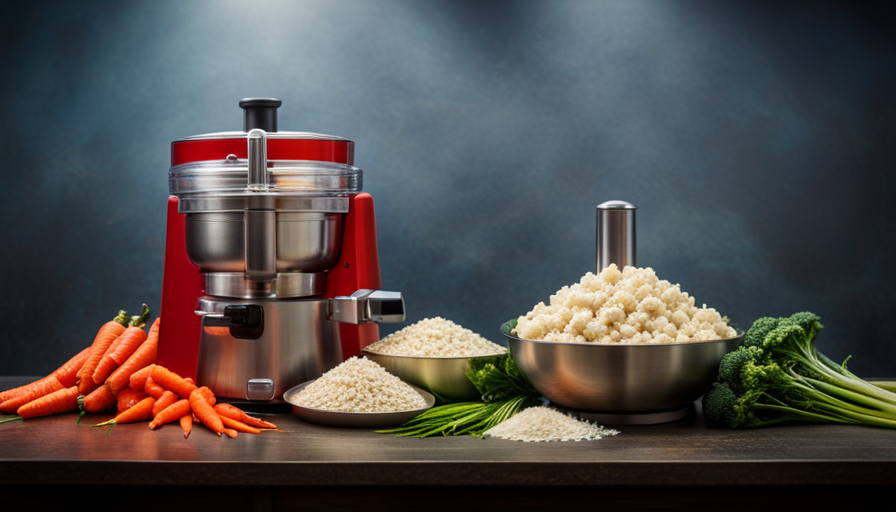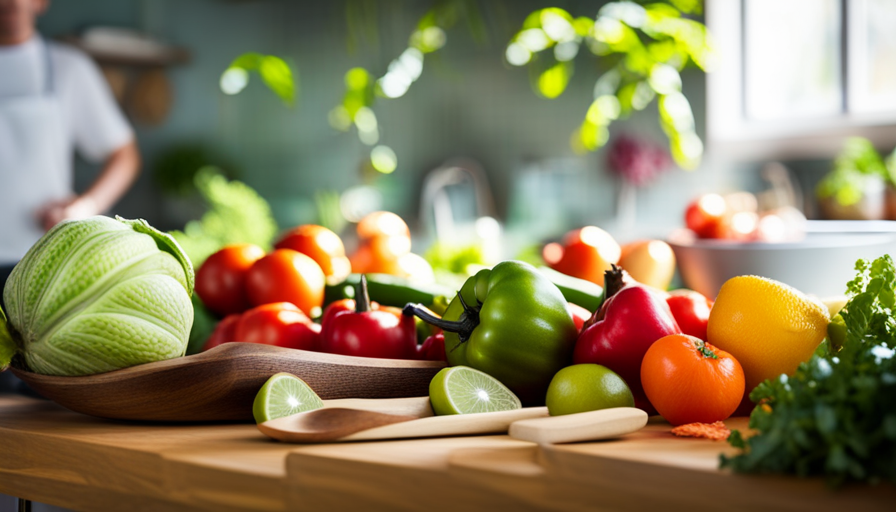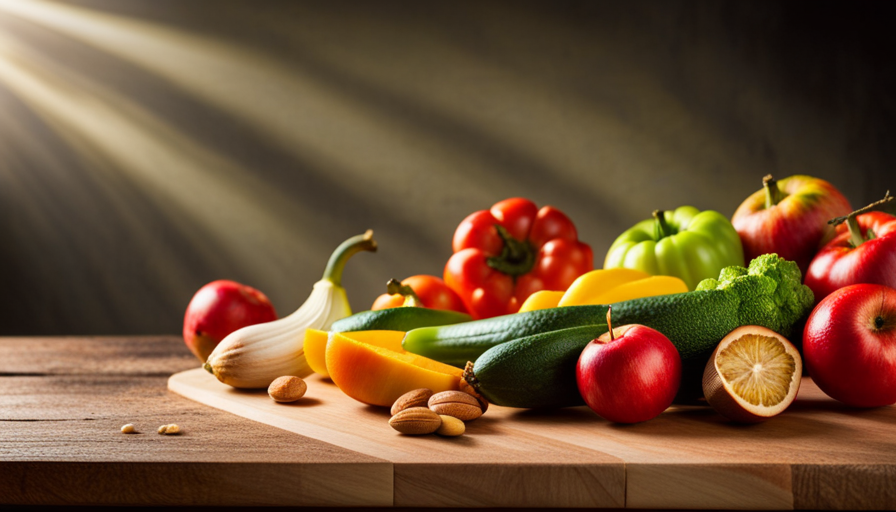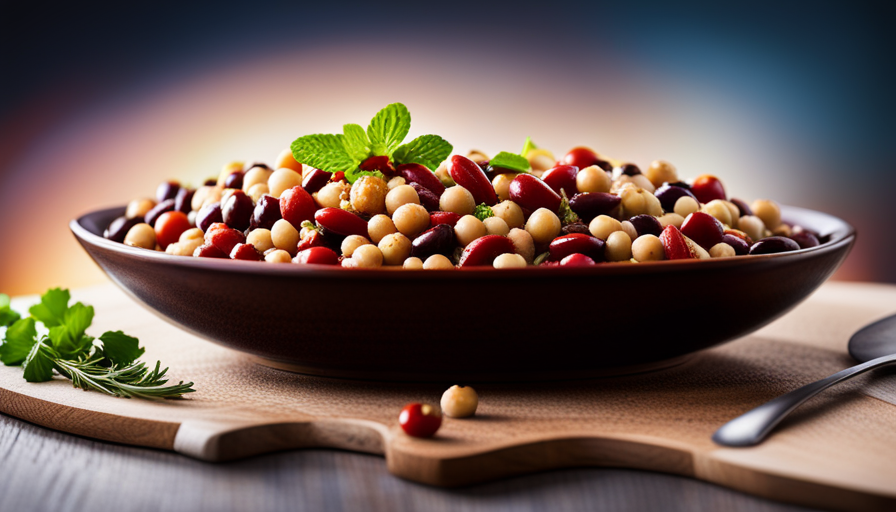Winter has arrived, and although the cold weather may make you desire cozy, hot meals, there is still a way to incorporate the advantages of raw food even in the midst of winter. Imagine yourself in a snowy paradise, with snowflakes delicately drifting from above, while you feed your body with colorful, nutrient-packed raw dishes.
Eating raw food in the winter can be a refreshing and invigorating experience, providing you with essential vitamins, minerals, and enzymes that support your overall health and well-being. But how can you make raw food work for you when the temperatures drop?
In this article, we will explore the benefits of eating raw food in the winter, share practical tips for incorporating warmth into your raw meals, and provide you with delicious recipes that utilize seasonal and winter-friendly ingredients.
Get ready to embrace the raw food lifestyle even in the midst of winter’s frosty embrace.
Key Takeaways
- Winter is a great time to enjoy raw food and reap its benefits.
- Incorporate a variety of seasonal raw fruits, vegetables, nuts, and seeds into meals.
- Root vegetables like carrots, beets, and turnips are packed with vitamins and minerals.
- Balancing raw and cooked foods in the winter diet is important for digestion and comfort.
Understanding the Benefits of Eating Raw Food
You’ll be amazed at the incredible health benefits you’ll experience when you start incorporating raw food into your winter diet. Raw food is packed with essential nutrients and enzymes that can greatly benefit your immune system, helping to ward off common winter illnesses.
The immune-boosting benefits of raw food can help keep you healthy and strong during the colder months.
Not only does raw food provide a natural boost to your immune system, but it can also aid in weight loss. Raw fruits and vegetables are low in calories and high in fiber, making them a great option for those looking to shed a few pounds. The high water content in raw food can also help you feel fuller for longer, reducing the temptation to snack on unhealthy, calorie-dense foods.
In addition to these benefits, raw food is also rich in antioxidants, which can help protect your body against the damaging effects of free radicals. These harmful molecules can contribute to chronic diseases and premature aging, so incorporating raw food into your winter diet can have long-term health benefits.
To make the most of these benefits, try incorporating a variety of raw fruits, vegetables, nuts, and seeds into your meals. You can enjoy them in salads, smoothies, or even as snacks throughout the day. Remember to wash your produce thoroughly and choose organic options whenever possible to minimize exposure to pesticides.
Choosing Seasonal and Winter-friendly Raw Ingredients
When selecting ingredients for your winter raw meals, it’s important to consider the seasonality and adaptability of the produce. Seasonal raw food not only ensures freshness but also provides the necessary nutrients to keep you healthy during the winter months.
Here are some winter-friendly raw ingredients to incorporate into your meals:
-
Root Vegetables: Winter is the perfect time to enjoy the earthy flavors of root vegetables like carrots, beets, and turnips. These veggies are packed with vitamins and minerals, and their natural sweetness adds a delicious touch to your raw dishes.
-
Citrus Fruits: Brighten up your winter meals with the vibrant flavors of citrus fruits like oranges, lemons, and grapefruits. These fruits are not only refreshing but also rich in vitamin C, which boosts your immune system and helps fight off winter colds.
-
Leafy Greens: Don’t forget to include leafy greens like kale, spinach, and Swiss chard in your winter raw recipes. These greens are packed with antioxidants and vitamins, keeping you energized and nourished throughout the season.
By choosing seasonal and winter-friendly raw ingredients, you can create delicious and nutritious meals that’ll keep you feeling satisfied and healthy. So go ahead and explore the world of seasonal raw food and discover the endless possibilities of winter-friendly raw recipes.
Incorporating Warmth into Raw Meals
Indulge in the comforting embrace of warmth by infusing your raw meals with cozy flavors and soothing textures. Adding warmth to raw meals during the winter can make them more satisfying and enjoyable. By incorporating certain ingredients and techniques, you can create raw food winter recipes that are both nourishing and comforting.
One way to add warmth to your raw meals is by using spices and seasonings that evoke a cozy feeling. Cinnamon, nutmeg, ginger, and cloves are all perfect choices for adding a touch of warmth to your dishes. These spices not only provide comforting flavors but also offer numerous health benefits.
Another way to incorporate warmth into your raw meals is by using comforting textures. Creamy avocados, silky smooth nut butters, and crunchy nuts can all add a satisfying element to your dishes. Pairing these textures with fresh fruits and vegetables can create a well-rounded and nourishing meal.
To make it easier for you to incorporate warmth into your raw meals, here is a table with some ideas for adding cozy flavors and soothing textures:
| Cozy Flavors | Soothing Textures |
|---|---|
| Cinnamon | Avocado |
| Nutmeg | Nut butters |
| Ginger | Crunchy nuts |
| Cloves |
By adding warmth to your raw meals, you can enjoy the benefits of a raw food diet even during the winter months. Experiment with different ingredients and techniques to create delicious and nourishing raw food winter recipes.
Preparing Nourishing Raw Soups and Stews
Savor the nourishing notes of nature’s bounty with soul-warming, savory raw soups and stews. Even in the winter, you can enjoy the benefits of raw food by preparing these nourishing dishes. Raw soups and stews aren’t just delicious, but they also retain more nutrients compared to cooked versions.
Here are some raw food soup and stew recipes that’ll keep you warm and satisfied during the winter months:
-
Creamy Butternut Squash Soup: Made with raw butternut squash, cashews, and warming spices, this soup is rich in vitamins A and C and provides a comforting taste.
-
Hearty Vegetable Stew: Packed with a variety of raw vegetables like carrots, celery, and bell peppers, this stew is a great source of fiber and antioxidants.
-
Spicy Tomato Gazpacho: This raw soup is bursting with flavor from fresh tomatoes, cucumbers, and herbs. It’s a refreshing option that can be served chilled or at room temperature.
-
Creamy Avocado Soup: Avocados are the star ingredient in this creamy soup, providing healthy fats and a smooth texture. Pair it with a side salad for a complete meal.
By incorporating these raw soups and stews into your winter menu, you can enjoy the benefits of raw food while staying warm and nourished. Experiment with different ingredients and flavors to create your own unique recipes.
Creating Hearty Raw Salads for Winter
Try incorporating hearty raw salads into your winter menu to enjoy a nourishing and satisfying meal. Despite the cold weather, you can still enjoy the benefits of raw food by preparing delicious winter salads. These salads are packed with nutrients and can help boost your immune system during the winter months. Here are some winter salad recipes to inspire you:
| Salad Name | Ingredients | Dressing |
|---|---|---|
| Winter Harvest | Kale, roasted sweet potatoes, cranberries | Lemon tahini dressing |
| Roasted Brussels | Brussels sprouts, roasted pecans, pomegranate | Balsamic vinaigrette |
| Citrus Delight | Mixed greens, oranges, avocado, almonds | Orange poppy seed dressing |
| Mediterranean | Romaine lettuce, cucumber, olives, feta | Greek vinaigrette |
These hearty raw salads will not only provide you with a variety of flavors and textures, but they will also keep you feeling full and satisfied. To make them even more filling, you can add some protein-rich ingredients like chickpeas, quinoa, or tofu. Remember to wash your ingredients thoroughly and use fresh produce to ensure maximum nutritional value. So, don’t let the winter deter you from enjoying raw foods. Incorporate these delicious salads into your winter menu for a healthy and refreshing meal option.
Exploring Raw Snack and Dessert Options
Now that you’ve learned how to create hearty raw salads for winter, let’s dive into the exciting world of raw snack and dessert options. Just because it’s winter doesn’t mean you have to miss out on delicious treats. In fact, this is the perfect time to explore raw holiday treats that are not only scrumptious but also nutritious.
When it comes to raw snacks, you have an abundance of choices. Raw nuts and seeds make for a satisfying and energy-boosting snack. You can also try making raw vegetable chips by thinly slicing veggies like kale or zucchini and dehydrating them until crispy. These chips are not only delicious but also packed with vitamins and minerals.
As for raw desserts, you’ll be amazed by the variety of options available. Raw fruit tarts, made with a nut and date crust and topped with fresh fruit, are a crowd-pleaser at parties. Raw chocolate truffles, made with cacao powder, dates, and nuts, are a decadent treat that will satisfy any sweet tooth.
So, next time you’re hosting a party or craving a snack, don’t hesitate to explore the world of raw food for parties. With these raw snack and dessert options, you can enjoy guilt-free indulgence while nourishing your body with wholesome ingredients.
Using Winter Produce in Raw Food Recipes
Indulge in the vibrant flavors and textures of seasonal produce to create mouthwatering raw recipes for the colder months. Winter may seem like a challenging time to embrace raw food, but with the right ingredients and techniques, you can still enjoy delicious and nutritious meals.
One way to add warmth and depth to your raw recipes is by using winter spices. Cinnamon, nutmeg, ginger, and cloves are all wonderful options to infuse your dishes with cozy flavors. Sprinkle these spices into your smoothies, sprinkle them over your raw desserts, or incorporate them into your savory dishes for a touch of warmth.
Another way to adapt raw food techniques to winter ingredients is by exploring the wide variety of produce available during this season. Root vegetables like carrots, beets, and sweet potatoes can be transformed into delicious raw salads or spiralized into noodles for raw pasta dishes. Dark leafy greens such as kale, Swiss chard, and spinach are also abundant during winter and can be used as the base for hearty raw salads or blended into nutrient-packed green smoothies.
Don’t forget about winter fruits like citrus, apples, and pears. These fruits can add a burst of freshness and sweetness to your raw recipes. Slice them up for a refreshing fruit salad or use them as toppings for your raw desserts.
By using winter spices and adapting raw food techniques to winter ingredients, you can continue to enjoy the benefits of raw food even during the colder months. So get creative, explore new flavors, and embrace the bounty of winter produce in your raw food recipes.
Storing and Preserving Raw Food in Cold Weather
Embrace the challenge of preserving the vibrant flavors of your seasonal creations, ensuring that the essence of your culinary artistry remains intact even in the midst of cold weather. Storing and preserving raw food in cold weather requires proper techniques to maintain freshness and nutritional value.
One effective method is to use airtight containers to store your raw fruits and vegetables. This helps to prevent moisture loss and keep them crisp and flavorful. It’s also important to keep them in a cool and dark place, such as a pantry or cellar, to protect them from temperature fluctuations.
Freezing is another great option for preserving raw food. Before freezing, make sure to wash and dry your produce thoroughly. Chop them into the desired size and place them in airtight freezer bags or containers. Flash freezing is a technique where you spread out the chopped produce on a baking sheet and freeze them for a few hours before transferring them to freezer bags. This prevents them from sticking together and makes it easier to use only the amount you need.
Remember to label your frozen raw food with the date to keep track of their freshness. When using them, thaw them in the refrigerator overnight or use them directly in smoothies or soups.
By using these storing techniques and freezing methods, you can enjoy the benefits of raw food even in the winter months.
Boosting Immunity with Raw Winter Superfoods
Enhance your wellness during the colder months by incorporating nutrient-rich superfoods into your diet, bolstering your immune system and promoting overall health. Here are four winter superfoods that can help boost your immunity:
-
Citrus fruits: Packed with vitamin C, citrus fruits like oranges, grapefruits, and lemons are excellent for strengthening your immune system. Vitamin C is known to increase the production of white blood cells, which are essential for fighting off infections.
-
Garlic: This pungent bulb not only adds flavor to your dishes but also has immune-boosting properties. Garlic contains compounds that stimulate the production of white blood cells, helping your body fight off viruses and bacteria.
-
Spinach: This leafy green vegetable is an excellent source of vitamins A, C, and E, as well as antioxidants. These nutrients not only support a healthy immune system but also protect your cells from damage.
-
Ginger: Known for its anti-inflammatory and antioxidant properties, ginger can help strengthen your immune system. It also has antimicrobial properties that can help fight off infections.
By incorporating these winter superfoods into your diet, you can give your immune system a much-needed boost during the colder months. Stay healthy and enjoy the benefits of these nutrient-packed foods!
Balancing Raw and Cooked Foods in the Winter Diet
Boosting your immunity with raw winter superfoods is a great way to stay healthy during the colder months. However, it’s important to find a balance between raw and cooked foods in your winter diet.
While raw foods offer numerous health benefits, they can be harder to digest during the winter when our bodies crave warmth. Incorporating some cooked foods into your meals can help provide the nourishment and comfort your body needs.
One way to strike this balance is by incorporating warming cooked foods into your raw meals. For example, you can add steamed vegetables or cooked grains to your raw salads. This will not only provide warmth but also make your meal more satisfying.
Another option is to focus on seasonal produce that is naturally warming. Root vegetables like sweet potatoes, carrots, and beets are excellent choices. These can be eaten raw or lightly cooked to retain their nutritional value while providing that comforting warmth.
Remember, everyone’s body is different, so it’s important to listen to your own needs and preferences. Experiment with different combinations of raw and cooked foods to find what works best for you. By finding the right balance, you can enjoy the benefits of raw food in your winter diet while still keeping your body nourished and satisfied.
Frequently Asked Questions
How can I make sure I get enough nutrients from raw food during the winter?
To ensure you’re getting enough nutrients from raw food during the winter, get creative with incorporating them into your recipes. Symbolically, think of raw food as a vibrant burst of life amidst the cold and grey months. Try adding raw fruits and vegetables to warm soups, stews, or stir-fries.
As for storage, keep raw food fresh by using airtight containers or freezing them. This way, you can enjoy the benefits of raw food all winter long.
Are there any specific precautions I should take when eating raw food in cold weather?
To ensure your safety and well-being when eating raw food in cold weather, there are a few precautions you should take. First, wash all fruits and vegetables thoroughly to remove any potential contaminants.
Additionally, make sure to store your raw food properly to prevent bacterial growth. It’s also important to consume a varied diet to ensure you receive all the necessary nutrients.
Despite the challenges, eating raw food in winter can offer numerous benefits, such as increased energy levels and improved digestion.
Can I still enjoy a variety of flavors and textures with raw food in the winter?
Winter may seem like a challenge for enjoying flavorful raw food, but fear not! There are plenty of delicious options to satisfy your taste buds. From zesty citrus salads to creamy avocado soups, the possibilities are endless.
Not only do these recipes offer an explosion of flavors, but they also come with added benefits. Raw food in winter can boost your immune system, provide essential nutrients, and keep you feeling energized.
So, embrace the season and indulge in the goodness of raw food!
Are there any specific kitchen tools or equipment I need for preparing raw food in the winter?
To prepare raw food in the winter, there are a few specific kitchen tools that can be helpful. First, a high-speed blender is essential for making smoothies and soups. It’ll ensure your ingredients are well blended and smooth.
Additionally, a food processor is useful for chopping and mixing ingredients for salads or raw desserts.
Lastly, a dehydrator is great for making dried fruits, nuts, and even raw crackers.
These tools will make preparing raw food in the winter easier and more enjoyable.
Is it necessary to eat only raw food during the winter, or can I incorporate cooked food as well?
During the winter, it’s not necessary to eat only raw food. You can incorporate cooked food into your diet as well. This allows for a more balanced approach and provides warmth and comfort during the colder months.
However, it’s still important to include raw food options in your meals. This can be achieved by incorporating raw fruits, vegetables, and salads alongside your cooked dishes.
Is It Safe for Toddlers to Eat Raw Food in the Winter?
Feeding raw food to toddlers in the winter can be risky due to the potential for foodborne illnesses. It’s best to stick to cooked foods to avoid any health concerns. Make sure to wash fruits and vegetables thoroughly to reduce the risk of contamination.
Conclusion
In conclusion, incorporating raw food into your winter diet can provide numerous health benefits. Not only does it help boost your immune system with the abundance of winter superfoods, but it also ensures that you’re getting a wide variety of nutrients. Did you know that a study conducted by the University of California found that individuals who consume a predominantly raw food diet have lower levels of inflammation in their bodies? This statistic further emphasizes the importance of incorporating raw food into your winter meals.
So, don’t let the cold weather discourage you from enjoying the nourishing benefits of raw food!










